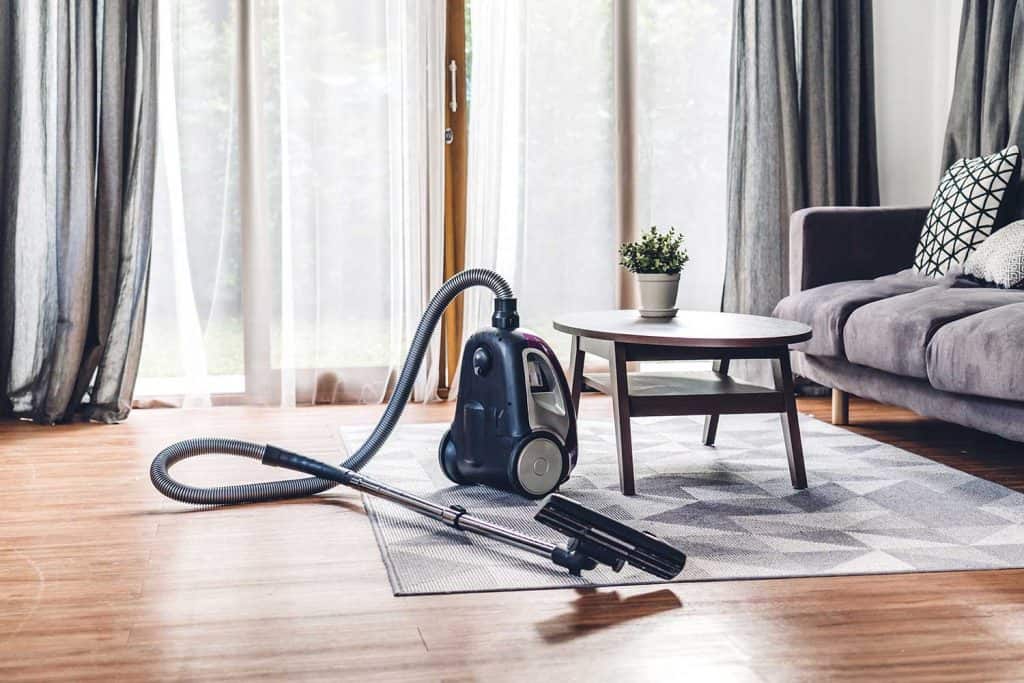Vinyl Plank Flooring In Bedroom
Vinyl Plank Flooring In Bedroom
If you're sick of the carpet in your bedroom and looking for something fresh and new, you might be wondering what else you can use. Quick and easy vinyl flooring is popular in other rooms, such as the kitchen, but can you put vinyl flooring in the bedroom? We've looked into interior design recommendations and vinyl flooring properties to determine whether it is a good choice for the bedroom.
You can absolutely use vinyl flooring in the bedroom. Though carpet is the most popular choice for bedroom floors in North America, it's not always the right option. Vinyl is rapidly climbing in popularity as the "new" flooring choice.
So when is vinyl better than carpet? How do you install vinyl, and how complicated is it? How do you select a pattern? Keep reading to learn more about this less traditional yet trendy flooring option!

Why Use Vinyl Flooring In The Bedroom?
Bedroom carpeting is common, but it's not without drawbacks, including:
- It traps allergens and dust. Because of this, it's a bad choice for allergy sufferers.
- It can be hard to keep clean, especially if a liquid is spilled.
- While carpet is warm and soft, people in hot and humid areas such as Florida rarely find that desirable.
Vinyl is growing in popularity as an alternative to the more traditional bedroom carpet. In fact, vinyl plank flooring made Realtor.com's Top 10 Flooring of 2020 list! Some benefits of vinyl include:
- Very easy to clean and low maintenance.
- Easy to install and inexpensive.
- Softer surface than hardwoods or other floorings (the only thing softer is carpet). This is an important factor in a bedroom where someone may fall (such as a child rolling out of bed or an elderly family member).
- Durable and lasts longer than carpet. If you share your bedroom with pets, vinyl is a great choice that resists scratches and scuffs from little claws.
- Warmer than other hard floorings such as tile.
- Variety of colors, patterns, and designs.

How to install vinyl flooring
For both sheet and plank vinyl flooring, you'll start by leaving your vinyl to acclimate to the room temperature. Let it sit for at least 24-hours. Make sure the floor is smooth, clean, and prepared. Remove baseboards, nails, and other trim.
Plank Vinyl Installation
- Place shims against the wall to leave a 5/16-inch expansion gap. An alternate method is to mark your gap with a chalk line.
- Measure the room to determine how many rows you will need to place and how wide the last row will be. If it's very narrow, you may want to "split the difference" by cutting the first row accordingly. This means your starting and ending row will have equal width.
- Score and cut the tongue of your first plank. Place the cut side to the wall (leaving your expansion gap in place).
- Angle your next plank and snap it into place. Continue as needed.
- When you reach the end of the first row, score the plank and snap it to adjust the size as needed. Note that the end piece should always be at least 6-inches long. If it's not, cut enough off the first plank to correct this, and slide the whole thing over.
- Continue this pattern row by row, locking the tongue into the row before. Make sure that the joints of the flooring are staggered by at least 6-inches. Cut your starting and end pieces appropriately.
- Replace baseboards and other trim.

Sheet vinyl installation
- Cut vinyl 3-inches wider than the floor on all sides (you can trim the excess later).
- Lay vinyl on the floor. Let the extra inches on the edges curl up to the wall. You may want to place a scrap of plywood down to protect your subfloor before doing any cutting.
- Make any cuts as needed, trimming any corners or edges carefully. Use small vertical lines or small v-shaped cuts. Remove just a little material at a time; it's better to go slow than to take out too much.
- Use a 2″ x 4″ board to crease the vinyl at the edge of the wall (where the floor and the wall meet).
- Use a straight edge to cut the excess vinyl. Leave 1/8th of an inch of space by the wall for an expansion gap.
- If your new floor has a seam, make sure it is at least 6-inches from the old floor's seam (if there is one).
- Replace baseboards and other trim.
Do I need underlayment for vinyl sheet flooring?
Vinyl sheet flooring will eventually settle, and the texture of the floor underneath will show through. Any uneven marks, dips, or patterns in the old flooring will "bleed" through to the new vinyl. There are several options for preparing the surface for vinyl sheet flooring to avoid this:
Laid directly
Vinyl sheet flooring can be laid directly if the existing floor is smooth and in good condition (for example, on concrete or linoleum).
Embossing leveler
If there are bumps, indentations, or rough patterns on the current floor, you can apply embossing leveler with a straightedge trowel. This will smooth the surface but is best for when flaws in the floor are not too severe.
Underlayment
Use plywood as an underlayment. This is the solution when the entire surface will need to be leveled, and removing current floors is impractical (for example, buckled or hardwood floors).
Moisture barrier
If the surface is smooth, but moisture is an issue, you may want to use a vapor barrier as an underlayment. Select one that will not add cushioning, as this can interfere with the planks' ability to snap together.
These scenarios are just an example of when underlayment may or may not be used. Always follow the specific manufacturer's instructions for vinyl flooring installation.
What thickness vinyl flooring is best?
When selecting vinyl flooring, there are actually two numbers to keep in mind: plank thickness and wear layer thickness. Be very careful when shopping, as it's easy to get these numbers mixed up.
Plank thickness
This one is pretty straightforward. It's the actual thickness of the actual plank. Measurements come in millimeters (mm), with higher quality floors being 8-mm or more.
Wear layer thickness
The wear layer is one of the multiple layers in a vinyl plank. The thicker the wear layer, the longer the floor should theoretically last (though other factors, such as the quality of the planks, installation, and maintenance, will contribute to their actual lifespan). Most contractors use 12-mil or greater in homes. Homes with pets may want to stick to 20-mil as a minimum.
When choosing plank thickness, there isn't one correct number. While higher quality floors are thicker, thicker is not necessarily the best. Consider any adjoining flooring – how thick do you want your flooring to make a good transition between rooms? Floors that are either too thin or too thick will create an uneven transition, potentially a tripping hazard.
Can I put an area rug on vinyl flooring?
Area rugs over vinyl flooring are entirely a matter of preference and your own personal style! If you're selecting vinyl flooring because of its hygienic and non-allergenic appeal, you might want to skip the area rug.

On the other hand, there are some advantages of using area rugs in the bedroom to get the best of both worlds. These include:
- Increased comfort
- Warmer floors
- Can prevent scuffing in high-traffic areas
- Pulls decor elements of the room together
- Focal point – can direct attention in the room to a certain area
Read more about area rugs here: Do You Need Area Rugs On Hardwood Floors?
Should bedroom floors match throughout the house?
There are two methods for selecting flooring in a home, matching flooring and coordinated flooring. The one you select is a matter of preference.
Matching floors
When the flooring is matching, it is exact from one room to another. If this is the style you choose, then it is crucial to make an exact match. Nothing can be more visually disruptive than something that is almost-but-not-quite the same. For this reason, you will want to take careful notes, a sample, or a picture when you buy new flooring – to make sure what you purchase is a match. Think twins, not cousins.
Coordinated floors
Coordinated floors give a lot more freedom and opportunity in your selection. In this style, you want to find and repeat similar flooring elements, but it doesn't have to match.
For example, you may want a hardwood floor in the living room. This floor may be similarly colored to the kitchen floor, but you use tile in the kitchen. The color is the same; the material is not. Then in the bedroom, you select a hardwood floor with a shade lighter than the one in the living room. Now the material is the same, but the color is not.
In this decor, it's perfectly acceptable for the various floorings to be more like cousins than exact twins. You also have a bit more room to consider the function of each room when selecting flooring. One consideration here is that it's best to switch floorings at natural breaking points (for example, in a door frame instead of in the middle of a hallway).
What is the most popular color for vinyl flooring?
Grey is a popular color for 2020. Other trending vinyl colors and patterns include:
Wood
Vinyl that mimics hardwood floors is classic, with blonde and grey wood being popular right now. Some current best-sellers include:
This tile combines two popular elements – faux wood and the color grey. Plus, it's self-adhesive and easy to install.

Click here to see Nexus Self Adhesive 12″x 12″ Charcoal Grey at Amazon.
These adhesive planks are waterproof, and each pack covers 24-square-feet in total.

Click here to see Vinyl Floor Planks Adhesive Floor Tiles in Ash at Amazon.
Stone
This dark slate lends a regal but earthy tone.

Click here to see Highly Durable Vinyl Tile, Dark Slate Marble, 20-Pack (12-inch) at Amazon.
Black marble is another timeless look that's surging in popularity, like this high-gloss vinyl tile.

Click here to see Vinyl Tile with White Vein on Amazon.
Pattern
Vintage-inspired tiles such as this one are a hot ticket item. Maybe the craziness of 2020 makes us all long for a simpler time…or maybe this look just never goes out of style!

Click here to see Nexus 12-inch Vinyl Tile, Solid Black and White at Amazon.
If you're looking for something a bit more ornate, detailed patterns that are far from simple are also trending, like this best-seller in grey.

Click here to see FloorPops Medina Peel & Stick Floor Tile, Grey on Amazon.
In Closing
While carpeting is still used in most bedrooms, it certainly isn't the only choice. Vinyl flooring is a great selection for bedrooms, especially in situations where kids or pets make a more durable, stain-resistant floor the preferred option. Modern vinyl flooring comes in various colors, patterns, and styles that can fit in any decor.
Interested in bedroom decor ideas? Check out our related posts:
Vinyl Plank Flooring In Bedroom
Source: https://homedecorbliss.com/put-vinyl-flooring-in-bedroom-and-how-to-do-that/



Tidak ada komentar:
Tulis komentar